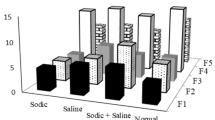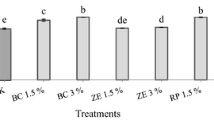Abstract
Purpose
Biochars may enhance the retention capacity of metals in soils, especially in highly weathered tropical soil whose low cation exchange capacity renders heavy metals mobile, and thus be able to leach from soils. We evaluated the effect of sugarcane-straw-derived biochar on sorption and desorption of Cd(II) and Zn(II) in two tropical soils in particular to distinguish primary and secondary mechanisms of metal retention.
Material and methods
To test the efficiency of biochar to retain heavy metals, sugarcane-straw-derived biochar was mixed with a clayey Oxisol and an Entisol both from the state of Sao Paulo, Brazil, in batch testing to obtain sorption-desorption isotherms of Cd(II) and Zn(II) and measure the release/displacement of cations (Ca2+ and Mg2+) or precipitation with phosphate during the sorption process.
Results and discussion
Biochar increased the sorption (including adsorption and precipitation) of both metals in both soils but that most sorption reactions were reversible under buffer acidic conditions, due to dissolution of precipitates in low pH values (<4.9). Exchange of Cd or Zn with Ca and Mg from the biochar was found to play a minor role on the retention mechanism, whereas surface precipitation (mainly in the Entisol) of the metals (e.g. with phosphate) was likely to be the main sorption mechanism.
Conclusions
Application of sugarcane-straw-derived biochar to heavy-metal-contaminated tropical soils seems justified because of its sorptive capacity for Cd and Zn. However, binding reactions on surfaces were reversible, mainly for Cd(II), resulting in the likelihood that repeat applications of biochar would be required to maintain reduced soil solution concentrations of Cd and Zn over time, thus avoiding phytotoxicity and associated environmental risks.


Similar content being viewed by others
References
Almaroai YA, Usman ARA, Ahmad M et al (2014) Effects of biochar, cow bone, and eggshell on Pb availability to maize in contaminated soil irrigated with saline water. Environ Earth Sci 71:1289–1296
Al-Wabel MI, Al-Omran A, El-Naggar AH et al (2013) Pyrolysis temperature induced changes in characteristics and chemical composition of biochar produced from conocarpus wastes. Bioresour Technol 131:374–379
Beesley L, Moreno-Jiménez E, Gomez-Eyles JL et al (2011) A review of biochars’ potential role in the remediation, revegetation and restoration of contaminated soils. Environ Pollut 159:3269–3282
Beesley L, Moreno-Jiménez E, Fellet G et al (2015) Biochar and heavy metals. Biochar Environ Manag Sci Technol
Bradl HB (2004) Adsorption of heavy metal ions on soils and soils constituents. J Colloid Interface Sci 277:1–18
Buss W, Mašek O (2014) Mobile organic compounds in biochar - a potential source ofcontamination - phytotoxic effects on cress seed (Lepidium sativum) germination. J Environ Manage 137:111–119
Downie A, Crosky A, Munroe P (2009) Physical properties of biochar. In: Lehmann J, Joseph S (eds) Biochar for environmental management: Science and technology, 1st edn. Earthscan, London, pp 13-32
Fontes MPF, Alleoni LRF (2006) Electrochemical attributes and availability of nutrients, toxic elements, and heavy metals in tropical soils. Sci Agric 589–608
Fuertes A, Arbestain M, Sevilla M (2010) Chemical and structural properties of carbonaceous products obtained by pyrolysis and hydrothermal carbonisation of corn stover. Soil Res 48:618–626
Glaser B, Lehmann J, Zech W (2002) Ameliorating physical and chemical properties of highly weathered soils in the tropics with charcoal - a review. Biol Fertil Soils 35:219–230
Haynes RJ, Naidu R (1998) Influence of lime, fertilizer and manure applications on soil organic matter content and soil physical conditions: a review. Nutr Cycl Agroecosystems 51:123–137
Ippolito JA, Stromberger ME, Lentz RD, Dungan RS (2015) Hardwood biochar and manure co-application to a calcareous soil. Chemosphere. doi:10.1016/j.chemosphere.2015.05.039
Jones DL, Rousk J, Edwards-Jones G et al (2012) Biochar-mediated changes in soil quality and plant growth in a three year field trial. Soil Biol Biochem 45:113–124
Karami N, Clemente R, Moreno-Jiménez E et al (2011) Efficiency of green waste compost and biochar soil amendments for reducing lead and copper mobility and uptake to ryegrass. J Hazard Mater 191:41–48
Kelly CN, Peltz CD, Stanton M et al (2014) Biochar application to hardrock mine tailings: soil quality, microbial activity, and toxic element sorption. Appl Geochemistry 43:35–48
Kim W-K, Shim T, Kim Y-S et al (2013) Characterization of cadmium removal from aqueous solution by biochar produced from a giant Miscanthus at different pyrolytic temperatures. Bioresour Technol 138:266–270
Lehmann J, Gaunt J, Rondon M (2006) Bio-char sequestration in terrestrial ecosystems – a review. Mitig Adapt Strateg Glob Chang 11:395–419
Lindsay WL, Norvell WA (1978) Development of a DTPA soil test for zinc, iron, manganese, and copper. Soil Sci Soc Am J 42:421–428
Loganathan P, Vigneswaran S, Kandasamy J, Naidu R (2012) Cadmium sorption and desorption in soils: a review. Crit Rev Environ Sci Technol 42:489–533
Melo LCA, Alleoni LRF, Carvalho G, Azevedo RA (2011) Cadmium- and barium-toxicity effects on growth and antioxidant capacity of soybean (Glycine max L.) plants, grown in two soil types with different physicochemical properties. J Plant Nutr Soil Sci 174:847–859
Melo LCA, Coscione AR, Abreu CA et al (2013) Influence of pyrolysis temperature on cadmium and zinc sorption capacity of sugar cane straw–derived biochar. BioResources 8:4992–5004
Mench M, Lepp N, Bert V et al (2010) Successes and limitations of phytotechnologies at field scale: outcomes, assessment and outlook from COST Action 859. J Soils Sediments 10:1039–1070
Moreno-Jiménez E, Esteban E, Peñalosa J (2012) The fate of arsenic in soil-plant systems. In: Whitacre DM (ed) Reviews of environmental contamination and toxicology SE - 1. Springer, New York, pp 1–37
Naidu R, Kookana RS, Sumner ME et al (1997) Cadmium sorption and transport in variable charge soils: a review. J Environ Qual 26:602–617
Puga AP, Abreu CA, Melo LCA, Beesley L (2015) Biochar application to a contaminated soil reduces the availability and plant uptake of zinc, lead and cadmium. J Environ Manage 159:86–93
Quirk RG, Zwieten L, Kimber S et al (2012) Utilization of biochar in sugarcane and sugar-industry management. Sugar Tech 14:321–326
Rees F, Simonnot MO, Morel JL (2014) Short-term effects of biochar on soil heavy metal mobility are controlled by intra-particle diffusion and soil pH increase. Eur J Soil Sci 65:149–161
Shinogi Y, Kanri Y (2003) Pyrolysis of plant, animal and human waste: physical and chemical characterization of the pyrolytic products. Bioresour Technol 90:241–247. doi:10.1016/S0960-8524(03)00147-0
Singh B, Singh BP, Cowie AL (2010) Characterisation and evaluation of biochars for their application as a soil amendment. Aust J Soil Res 48:516–525
Song W, Guo M (2012) Quality variations of poultry litter biochar generated at different pyrolysis temperatures. J Anal Appl Pyrolysis 94:138–145
Spokas KA, Koskinen WC, Baker JM, Reicosky DC (2009) Impacts of woodchip biochar additions on greenhouse gas production and sorption/degradation of two herbicides in a Minnesota soil. Chemosphere 77:574–581
Steiner C, Das KC, Garcia M et al (2008) Charcoal and smoke extract stimulate the soil microbial community in a highly weathered xanthic Ferralsol. Pedobiologia (Jena) 51:359–366
Tan X, Liu Y, Gu Y et al (2015) Immobilization of Cd(II) in acid soil amended with different biochars with a long term of incubation. Environ Sci Pollut Res. doi:10.1007/s11356-015-4523-6
Uchimiya M, Klasson KT, Wartelle LH, Lima IM (2011a) Influence of soil properties on heavy metal sequestration by biochar amendment: 1. Copper sorption isotherms and the release of cations. Chemosphere 82:1431–1437
Uchimiya M, Klasson KT, Wartelle LH, Lima IM (2011b) Influence of soil properties on heavy metal sequestration by biochar amendment: 2. Copper desorption isotherms. Chemosphere 82:1438–1447
Uchimiya M, Wartelle LH, Klasson KT et al (2011c) Influence of pyrolysis temperature on biochar property and function as a heavy metal sorbent in soil. J Agric Food Chem 59:2501–2510
Van Raij B, Quaggio JA, da Silva NM (1986) Extraction of phosphorus, potassium, calcium, and magnesium from soils by an ion exchange resin procedure. Commun Soil Sci Plant Anal 17:547–566
Xu R-K, Zhao A-Z (2013) Effect of biochars on adsorption of Cu(II), Pb(II) and Cd(II) by three variable charge soils from southern China. Environ Sci Pollut Res 20:8491–8501
Xu X, Cao X, Zhao L (2013) Comparison of rice husk- and dairy manure-derived biochars for simultaneously removing heavy metals from aqueous solutions: role of mineral components in biochars. Chemosphere 92:955–961
Yang Y, Chun Y, Sheng G, Huang M (2004) pH-dependence of pesticide adsorption by wheat-residue-derived black carbon. Langmuir 20:6736–6741
Yuan J-H, Xu R-K, Qian W, Wang R-H (2011) Comparison of the ameliorating effects on an acidic ultisol between four crop straws and their biochars. J Soils Sediments 11:741–750
Acknowledgments
The authors are grateful for the financial support of the São Paulo Research Foundation—FAPESP (Grant number 2011/12346-3) and for the postdoctoral fellowship (Grant number 2011/02844-6) for the first author.
Author information
Authors and Affiliations
Corresponding author
Additional information
Responsible editor: Dong-Mei Zhou
Rights and permissions
About this article
Cite this article
Melo, L.C.A., Puga, A.P., Coscione, A.R. et al. Sorption and desorption of cadmium and zinc in two tropical soils amended with sugarcane-straw-derived biochar. J Soils Sediments 16, 226–234 (2016). https://doi.org/10.1007/s11368-015-1199-y
Received:
Accepted:
Published:
Issue Date:
DOI: https://doi.org/10.1007/s11368-015-1199-y




